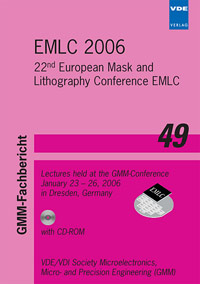A New Generation of Progressive Mask Defects on the Pattern Side of Advanced Photomasks
Konferenz: EMLC 2006 - 22nd European Mask and Lithography Conference
23.01.2006 - 26.01.2006 in Dresden, Germany
Tagungsband: EMLC 2006
Seiten: 6Sprache: EnglischTyp: PDF
Persönliche VDE-Mitglieder erhalten auf diesen Artikel 10% Rabatt
Autoren:
Grenon, Brian J. (Grenon Consulting, Inc., 92 Dunlop Way, Colchester, VT 05446, USA)
Bhattacharyya, Kaustuve; Eynon, Benjamin (KLA-Tencor Corporation, 160 Rio Robles, San Jose, CA 95134, USA)
Inhalt:
The progressive mask defect problem is an industrywide mask reliability issue. Even if masks are determined to be clean upon arrival from the mask supplier, some of these masks can show catastrophic defect growth over the course of production usage in the fab. The categories of defects that cause reticlequality degradation over time are defined as progressive defects, commonly known as crystal growth, haze, fungus or precipitate. This progressive defect problem has been around for more than a decade and was observed at almost every lithographic wavelength. This problem is especially severe at 193nm lithography. Triggering the increased severity are shorter wavelength lithography - where the photons are highly energized - and the concurrent transition to 300 mm wafers, which require photomasks to endure more prolonged exposure as compared to 200 mm wafers. Both embedded phase shift masks (EPSMs) and chrome-on-glass masks are affected by progressive defects. These defects are generally found on the patterned surface underneath the pellicle (on clear, half-tone or chrome patterns), as well as on the backside surface of the masks. Past cases have indicated that this problem mainly starts on the scribes and borders, with emerging semi-transmissive contamination of ~100nm. These defects then propagate into the die area while growing in both size and opaqueness. Compositional analysis has shown that the majority of these defects are ammonium sulfate. However, since significant effort focused on the elimination of ammonium sulfate a new trend has emerged. Current studies show severe defect growth consists of organic contaminants (ammonium oxalate, cyanuric acid etc.) on half-tone edges and on chromium edges. The sources for progressive defect mechanisms are under investigation, though several candidates have been considered: mask-making materials and process residues (mainly ammonium or sulfate ions), the fab environment, or the stepper environment. Controlling or balancing these sources may help to reduce the frequency at which these defects occur, but thus far has been unable to eliminate the problem. With each successive device shrink, the resultant changes in lithographic wavelength and processing within the mask fabrication facility and IC fab disrupt the fine balance among the above suspected defect sources, resulting in the return of catastrophic progressive defect growth. Due to this uncertainty, strict mask quality monitoring in the fab is essential. The ideal reticle quality control goal in a fab should be to detect any nascent progressive defects before they become yield limiting. Hence, the masks should be monitored on an established frequency that allows problem masks to be removed from production and sent for rework prior to impacting device performance and fab yield.


